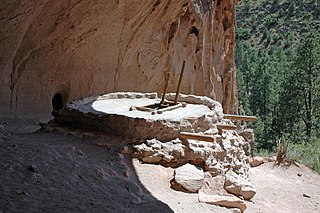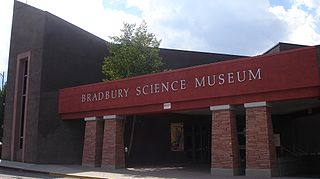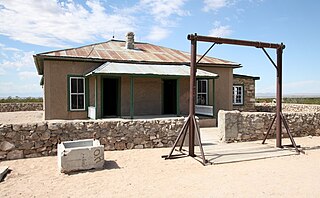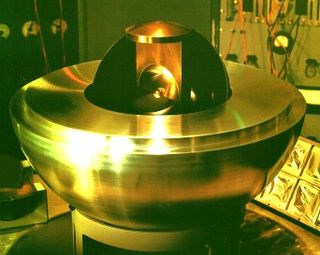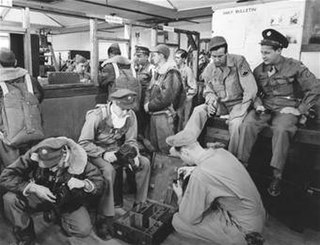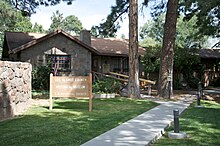 | |
| Location | New Mexico |
|---|---|
| Coordinates | 35°52′57″N106°18′07″W / 35.8825°N 106.3020°W |
The Los Alamos Historical Museum is housed in the historic Guest House, located next to Fuller Lodge, of Los Alamos Ranch School, which was General Leslie Groves's favorite place to stay during the Manhattan Project.

Los Alamos Ranch School was a private ranch school for boys in Los Alamos County, New Mexico, USA, founded in 1917 near San Ildefonso Pueblo. During World War II, the school was bought and converted into the secret nuclear research campus for Project Y. The surrounding location has developed into the town of Los Alamos.
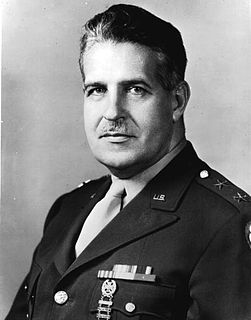
Lieutenant General Leslie Richard Groves Jr. was a United States Army Corps of Engineers officer who oversaw the construction of the Pentagon and directed the Manhattan Project, a top secret research project that developed the atomic bomb during World War II.

The Manhattan Project was a research and development undertaking during World War II that produced the first nuclear weapons. It was led by the United States with the support of the United Kingdom and Canada. From 1942 to 1946, the project was under the direction of Major General Leslie Groves of the U.S. Army Corps of Engineers. Nuclear physicist Robert Oppenheimer was the director of the Los Alamos Laboratory that designed the actual bombs. The Army component of the project was designated the Manhattan District; Manhattan gradually superseded the official codename, Development of Substitute Materials, for the entire project. Along the way, the project absorbed its earlier British counterpart, Tube Alloys. The Manhattan Project began modestly in 1939, but grew to employ more than 130,000 people and cost nearly US$2 billion. Over 90% of the cost was for building factories and to produce fissile material, with less than 10% for development and production of the weapons. Research and production took place at more than 30 sites across the United States, the United Kingdom, and Canada.
The museum features exhibits on the geological history of the Pajarito Plateau, including the volcanic explosion that created the world's second largest caldera, known as the Valles Caldera. It also has displays on the early settlers of the area, the Ancestral Pueblo Indians and the early homesteaders. The museum displays the history of the Los Alamos Ranch School, an elite educational institution for wealthy boys. It was founded by Ashley Pond II using the methods of the Boy Scouts of America to build both the bodies and the minds of boys, who wore shorts as part of their school uniforms, even during the winter. The school closed in 1943 when the United States government seized the property for the Manhattan Project, the top secret project to create the atomic bomb. Photos and artifacts in the museum document this time and tell the stories of the people who lived it.
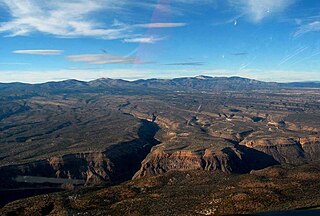
The Pajarito Plateau is a volcanic plateau in north central New Mexico, United States. The plateau, part of the Jemez Mountains, is bounded on the west by the Valles Caldera and on the east by the White Rock Canyon of the Rio Grande. The plateau is occupied by several notable entities, including Bandelier National Monument, the town of Los Alamos and its remote suburb White Rock, and Los Alamos National Laboratory. Elevations range from about 5600 feet at the river to about 7800 feet where the plateau merges into the mountain range.

Valles Caldera is a 13.7-mile (22.0 km) wide inactive volcanic caldera in the Jemez Mountains of northern New Mexico. Hot springs, streams, fumaroles, natural gas seeps and volcanic domes dot the caldera floor landscape. The highest point in the caldera is Redondo Peak, an 11,253-foot (3,430 m) resurgent lava dome located entirely within the caldera. Also within the caldera are several grass valleys [Valle(s)] the largest of which is Valle Grande, the only one accessible by a paved road. Much of the caldera is within the Valles Caldera National Preserve, a unit of the National Park System. In 1975, Valles Caldera was designated as a National Natural Landmark by the National Park Service.

The Boy Scouts of America (BSA) is one of the largest scouting organizations and youth organizations in the United States, with about 2.4 million youth participants and about one million adult volunteers. The BSA was founded in 1910, and since then, about 110 million Americans have been participants in BSA programs at some time. The BSA is part of the international Scout Movement and became a founding member organization of the World Organization of the Scout Movement in 1922.
The museum also has an area for traveling exhibits which have featured a wide variety of exhibitions about New Mexico history and World War II.

New Mexico is a state in the Southwestern region of the United States of America; its capital and cultural center is Santa Fe, which was founded in 1610 as capital of Nuevo México, while its largest city is Albuquerque with its accompanying metropolitan area. It is one of the Mountain States and shares the Four Corners region with Utah, Colorado, and Arizona; its other neighboring states are Oklahoma to the northeast, Texas to the east-southeast, and the Mexican states of Chihuahua to the south and Sonora to the southwest. With a population around two million, New Mexico is the 36th state by population. With a total area of 121,592 sq mi (314,920 km2), it is the fifth-largest and sixth-least densely populated of the 50 states. Due to their geographic locations, northern and eastern New Mexico exhibit a colder, alpine climate, while western and southern New Mexico exhibit a warmer, arid climate.

World War II, also known as the Second World War, was a global war that lasted from 1939 to 1945. The vast majority of the world's countries—including all the great powers—eventually formed two opposing military alliances: the Allies and the Axis. A state of total war emerged, directly involving more than 100 million people from over 30 countries. The major participants threw their entire economic, industrial, and scientific capabilities behind the war effort, blurring the distinction between civilian and military resources. World War II was the deadliest conflict in human history, marked by 50 to 85 million fatalities, most of whom were civilians in the Soviet Union and China. It included massacres, the genocide of the Holocaust, strategic bombing, premeditated death from starvation and disease, and the only use of nuclear weapons in war.


